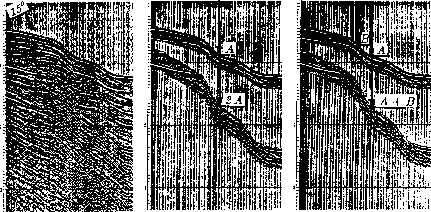Because of the wide offsets used in practice, it has become clear that
seismologists must pay attention to differences in the sea floor
from bounce to bounce.
A straightforward and appealing method of doing so was
introduced by Taner [1980]--that was his
radial-trace
method.
A radial trace is a line cutting through a common-shot profile along
some line of constant ![]() .Instead of deconvolving a seismogram at constant offset,
we deconvolve on a radial trace.
The deconvolution can be generalized to
a downward-continuation process.
Downward continuation of a radial trace may be approximated by time shifting.
Unfortunately, there is a problem when the data on the line
consists of both sea-floor multiples and peglegs, because these
require different trajectories.
The problem is resolved, at least in principle, by means of Snell waves.
Estevez, in his dissertation [1977],
showed theoretically how Snell waves could also
be used to resolve other difficulties,
such as diffraction and lateral velocity variation (if known).
An example illustrating the relevance of the
differing depths of the sea floor on different bounces, is shown in
Figure 15.
.Instead of deconvolving a seismogram at constant offset,
we deconvolve on a radial trace.
The deconvolution can be generalized to
a downward-continuation process.
Downward continuation of a radial trace may be approximated by time shifting.
Unfortunately, there is a problem when the data on the line
consists of both sea-floor multiples and peglegs, because these
require different trajectories.
The problem is resolved, at least in principle, by means of Snell waves.
Estevez, in his dissertation [1977],
showed theoretically how Snell waves could also
be used to resolve other difficulties,
such as diffraction and lateral velocity variation (if known).
An example illustrating the relevance of the
differing depths of the sea floor on different bounces, is shown in
Figure 15.
 |
Incompleteness of the data causes us to have problems with most inversion methods. Data can be incomplete in time, space, or in its spectrum. Any recursive method must be analyzed to ensure that an error made at shallow depths will not compound uncontrollably during descent. All data is spectrally incomplete. Also, with all data there is uncertainty about the shot waveform. At the p-values for which pegleg multiples are a problem, the first sea-floor bounce usually occurs too close to the ship to be properly recorded. To solve this problem, Taner built a special auxiliary recording system.
It is an advantage for Snell wave methods that slant stacking creates some signal-to-noise enhancement from the raw field data, but it is a disadvantage that the downward continuation must continue to all depths. The methods to be discussed next are before-stack methods, but they do not require downward continuation much below the sea floor.